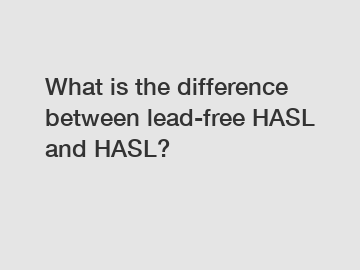What is the difference between lead-free HASL and HASL?
What is the difference between lead-free HASL and HASL?
Lead-free HASL (Hot Air Solder Leveling) and HASL (Hot Air Solder Leveling) are both widely used surface finishing techniques in printed circuit board (PCB) manufacturing. The main difference lies in the composition of the solder alloy used. HASL typically contains lead, while lead-free HASL uses alternative alloys that do not contain any lead.
The origin of the difference between lead-free HASL and HASL can be traced back to environmental and health concerns associated with the use of lead in various industries, including electronics manufacturing. Lead is a toxic substance and its disposal poses a significant risk to the environment. Additionally, prolonged exposure to lead can cause health issues, especially in workers involved in the manufacturing process. As a result, regulations have been put in place to restrict the use of lead in consumer products and electronic components.

To comply with these regulations, lead-free alternatives have been developed, one of which is lead-free HASL. The primary aim of lead-free HASL is to eliminate the use of lead while still providing a reliable and cost-effective surface finish for PCBs. The solder alloy used in lead-free HASL typically consists of a combination of tin, copper, and other alloying elements, such as silver or nickel.
The difference in solder alloy composition between lead-free HASL and HASL brings about various advantages and considerations. Firstly, lead-free HASL meets the requirements of environmental regulations and contributes to the reduction of hazardous waste. It is RoHS (Restriction of Hazardous Substances) compliant, which means that it does not contain restricted substances, including lead, mercury, and cadmium. This makes it a more environmentally friendly choice for PCB manufacturing.
Secondly, the solder alloy used in lead-free HASL exhibits improved solder joint reliability. It offers better thermal and mechanical properties, such as higher melting points and improved resistance to thermal cycling. This leads to increased durability and reliability of the solder joints, making lead-free HASL a suitable option for applications that require high-quality and long-lasting PCBs.
Furthermore, the transition to lead-free HASL may require adjustments in the PCB manufacturing process. The higher melting point of lead-free solder alloys necessitates modifications to the reflow profiles and rework processes. It also requires the use of dedicated equipment that can handle the higher temperatures involved. Therefore, manufacturers need to consider these factors when deciding between traditional HASL and lead-free HASL.
In conclusion, the main difference between lead-free HASL and HASL lies in the composition of the solder alloy used. Lead-free HASL eliminates the use of lead, addressing the environmental and health concerns associated with it. This alternative surface finish offers improved solder joint reliability and complies with industry regulations. However, it requires adjustments in the manufacturing process and the use of dedicated equipment. Overall, the adoption of lead-free HASL contributes to a safer and more sustainable PCB manufacturing industry.
Want more information on consumer electronics pcb , industrial control pcb , automotive pcb design ? Feel free to contact us.


